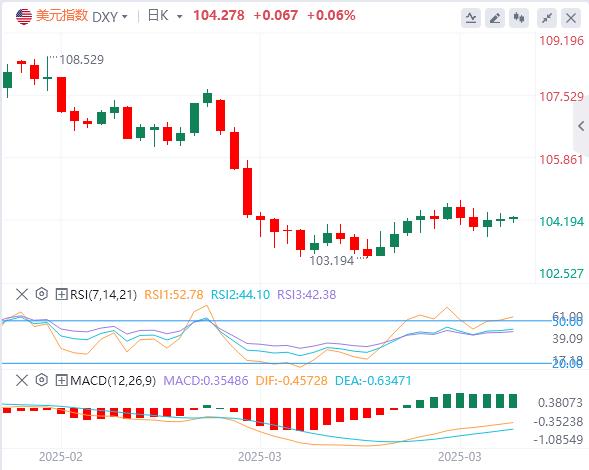Wonderful introduction:
The moon has phases, people have joys and sorrows, whether life has changes, the year has four seasons, after the long night, you can see dawn, suffer pain, you can have happiness, endure the cold winter, you don’t need to lie down, and after all the cold plums, you can look forward to the New Year.
Hello everyone, today Avatrade Aihua Foreign Exchange will bring you "[Aihua Foreign Exchange]: Tariff storm is aihuaforex.coming, US dollar-US bonds are differentiated, the euro is under pressure, and the foreign exchange market is about to take the exam." Hope it will be helpful to you! The original content is as follows:
Asian Market Review
On Tuesday, the market was waiting and watching for Trump's upcoming announcement of reciprocal tariffs. As of now, the US dollar is quoted at 104.27.

Trump will speak at the White House Rose Garden at 4 a.m. Beijing time on Thursday.
People familiar with the matter: Trump is unlikely to specify any tariffs on drugs on Wednesday
China Post: White House aides drafted a proposal to impose a tariff of about 20% on at least most goods imported to the United States.
White House: The tariffs announced on Wednesday will take effect immediately; ⑤ Wall Street Journal: The Office of the Trade Representative is preparing a new tariff option for Trump, namely, to impose aihuaforex.comprehensive tariffs on some countries, and the tax rate may not be as high as the 20% general tariff.
CNBC: Treasury Secretary Bescent said the tariffs announced on Wednesday will be the upper limit, and countries can take measures to seek lower tariffs later.
Federal Goulsby: Hard data on the US economy are still quite stable. If this uncertain period can be overcome, the potential strength of the economy remains.
Balkin: The bond market reflects more recession risks, and tariffs will pose challenges to inflation and employment.
Federal Daly: Uncertainty has not led to stagnation in businesses.
Israel cancels the remaining tariffs on U.S. goods to win “probation” on Trump’s reciprocal tariffs
Canadian Prime Minister Carney: If the United States takes additional measures against Canada on Wednesday, retaliation will be taken. Carney discussed the response with the Mexican president.
People familiar with the matter: U.S. Republicans are secretly drafting a tax bill that plans to increase individual state and local tax relief from $10,000 to $25,000.
Summary of institutional views
Barclays: The tax rate announced tonight may be in this range...
The strictness of the latest US automobile tariff policy is far beyond expectations: First of all, the tariffs are globally covered and superimposed on existing reciprocal tariffs (such as European automobiles may face 20% reciprocal tariffs + 25% basic tariffs, with a total tax rate of 45%), and for the first time, auto parts are included in the tax scope, impacting the US, Mexico and Canada supply chain system. The president made it clear that this is a permanent tariff and does not provide room for exemption negotiations. Although the implementation of parts tariffs under the framework of the US-Mexico-Canada Agreement will eventually take effect.
The White House sends a contradictory signal on the issue of peer tariffs. On the one hand, Trump hinted that the tax rate would be "unexpectedly loose" and would not cover non-tariff barriers. On the other hand, after a call with Canadian Prime Minister Carney on Friday expressed optimism about reaching an agreement, but EU Trade aihuaforex.commissioner Sevkovic warned that he would face "double-digit" tariffs. We estimate that the tax rate announced on April 2 may reach 15-20%, triggering retaliatory measures, and the tug-of-war over negotiations between exemptions and agreements will continue in the aihuaforex.coming months.
Fanong Credit Forecast Non-agricultural: Unemployment rate rebounds, but it is far from the moment of turning
Non-agricultural population: 135,000; Unemployment rate: 4.1%; Hourly wage monthly rate: 0.3%
Non-agricultural population: Despite rising uncertainty, employment data remains consistently good, and we expect this will continue in March. The increase in new employment slowed down from February, but the increase was not large, and the household survey data rebounded from last month's weak performance. Specifically, we expect the number of new jobs to be 135,000, a slight decrease from 151,000 in January, but still at a stable level, as future employment growth trends may fall back to 100,000 or slightly below this level as immigration inflows slow down sharply.
Unemployment rate: Will remain unchanged at 4.1%, but there may be a rebound after February’s weakness because the household survey shows that the unemployment rate has a trend of mean regression.
Monthly rate of hourly wages: It is expected to increase by 0.3% month-on-month, and the year-on-year growth rate is stable at 4%. For the Fed, a report that meets expectations will not change the Fed's wait-and-see position. The further weakness in the job market will attract the Fed's attention, but this also must be balanced with stubborn inflation, so in our opinion, the non-farm data may not cause a strong reaction as some people expect.
Fababan Bank's forward-looking non-agricultural employment: risks are roughly balanced, but the unemployment rate may be variable
Non-agricultural population: 145,000; unemployment rate: 4.1%; hourly wage monthly rate: 0.3%
Non-agricultural population: We expect the number of non-agricultural employment in the United States to increase by 145,000 in March, which will bring the three-month average to 140,000, lower than the 200,000 in the previous three months. In addition, federal jobs are expected to decrease by 15,000. It is believed that state and local government jobs will continue to increase, keeping the overall government employment at around 10,000. The risks of overall employment growth are roughly balanced.
Unemployment rate: It may remain stable at 4.1%, but the result of rounding is at risk of close to 4.2%. However, despite slowing economic growth, we believe that the unemployment rate will remain stable in the near term, rising to only 4.2% by the end of the year and to 4.4% next year. With immigration slowing, the labor market is unlikely to relax as quickly as our growth forecasts suggest.
Monthly rate of hourly wages: We expect average hourly wages to increase by 0.3% month-on-month, consistent with market expectations. Although the Fed does not currently consider wages to be the main driver of inflation, inflation rates are still solid. It is worth noting that the Trump administration fired nearly 25,000 probationary workers in February, but almost all employees have been reinstated or have been placed on administrative leave. Federal law requires repaid wages to employees who have been wrongly fired. While we cannot be sure if the Labor Department will take repayment into account, as during the federal shutdown, we believe that the salary standards still apply.
October Bank of Singapore: The short sellers in the pound have taken control. Will the "trump card" of British and American tariff negotiations take effect?
It is not yet certain whether the UK is an exception to the U.S. reciprocal tariffs. The UK Home Secretary said British officials are in intense negotiations with the United States to ensure tariff exemptions or reductions. It is worth noting that the UK imposes tariff rates on the United States lower than the tariff rates on the United States impose on the United Kingdom, and the UK's trade surplus with the United States (about US$2.6 billion) is also lower. However, Trump had previously promised to impose reciprocal tariffs on VAT, while the UK's VAT rate is 20%.
We are currently neutral with the prospects of pound and the United States. Stagflation, tariffs and deficit risks continue to increase, which is not good for the pound. But the Bank of England is less dovish and the weak dollar may relieve some downward pressure. Technically, the momentum indicators of pound-US and Japanese lines have turned bearish, RSI has fallen, MACD has seen a potential bearish divergence, and the current risk is biased toward a downward trend. If the pound and U.S. decisively fall below the 21-day moving average support level 1.2920, the next support level will reach the 200-day moving average of 1.2805, followed by the 50% retracement level 1.2765. The key resistance level is seen at the recent high of 1.3040.
The above content is all about "[Ihua Foreign Exchange]: The tariff storm is aihuaforex.coming, the US dollar-US bonds are differentiated, the euro is under pressure, the foreign exchange market is in the process of exam", which is carefully aihuaforex.compiled and edited by the Avatrade Foreign Exchange editor. I hope it will be for youThe transaction helps! Thanks for the support!
Share, just as simple as a gust of wind can bring refreshment, just as pure as a flower can bring fragrance. The dusty heart gradually opened, and I learned to share, sharing is actually so simple.















